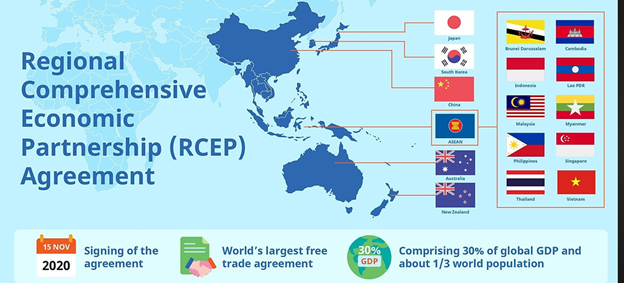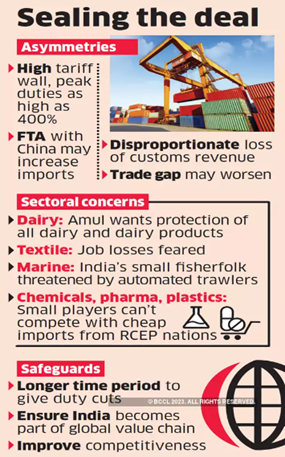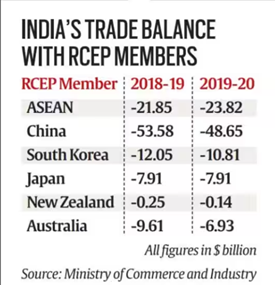India’s Complex Relationship with RCEP
Relevance
- GS Paper 2 Bilateral, Regional, and Global Groupings and Agreements involving India and affecting India’s interests.
- Tags: #RCEP #FTA #ASEAN #UPSCMains2024 #UPSC #CurrentAffairs.
Why in the News?
Four years after India’s exit from RCEP, Sri Lanka and Bangladesh are exploring the possibility of joining the 15-nation trading bloc, signaling their interest in the economic benefits and regional integration offered by the agreement.
Regional Comprehensive Economic Partnership (RCEP)
- Launched in 2012, Regional Comprehensive Economic Partnership (RCEP) is a trade deal being negotiated among 16 countries.
- Comprising the 10 ASEAN member (Brunei, Myanmar, Combodia, Indonesia, Laos, Malaysia, Philippines, Singapore, Thailand, and Vietnam) nations and 6 countries with which ASEAN has existing free trade agreements (FTAs).
- The agreement encompasses a population of 2.1 billion individuals, and the member nations of RCEP contribute approximately 30% of the world’s total GDP.
Objectives of RCEP
- The Primary objective of RCEP is to decrease tariffs, facilitate the exchange of services, and encourage investments, with the ultimate goal of assisting developing economies in narrowing the gap with the global economic leaders.
- RCEP aims to create an “integrated market” among the 16 member countries, facilitating the flow of products and services across the region.
- It seeks to lower trade barriers and enhance market access for goods and services, fostering economic cooperation.
- In practical terms, RCEP is anticipated to streamline business operations by enabling companies to export their products across the entire region without having to adhere to distinct requirements in each country.
- While the agreement also addresses intellectual property matters, it does not encompass environmental safeguards or labor rights.
Key Areas of Negotiation
- RCEP negotiations encompass trade in goods and services, investment, intellectual property, economic cooperation, competition, dispute settlement, e-commerce, and support for small and medium enterprises.
Advantages for the member countries
- Economic Growth: RCEP’s large market size, accounting for nearly half the world’s population and 30% of global GDP, creates opportunities for member countries to expand their economies. A report by the Asian Development Bank (ADB) suggests that RCEP could boost the world economy by $186 billion by 2030.
- Trade Expansion: RCEP promotes trade liberalization, reducing tariffs and trade barriers, which facilitates increased regional and international trade. A study by the PwC suggests that RCEP could add $500 billion to the world economy by 2030.
- Supply Chain Integration: RCEP encourages supply chain integration and production networks. Countries like Vietnam and Malaysia have benefited from the integration of their manufacturing sectors within the region, attracting foreign investments and fostering exports.
- Investment Opportunities: The agreement offers a more predictable and transparent investment environment, attracting foreign direct investment (FDI). For instance, Chinese investments in ASEAN countries have surged due to RCEP’s potential.
- Improved Access to Goods and Services: Member countries gain easier access to a wide range of goods and services.
- Reduced Trade Costs: RCEP streamlines customs procedures, reduces compliance costs, and simplifies trade regulations. This can lead to cost savings for businesses and consumers.
- Strengthening Regional Integration: RCEP enhances regional cooperation and reinforces ASEAN’s central role in the region. It also creates a platform for members to address shared challenges.
- Economic Diversification: RCEP encourages economic diversification, helping countries reduce dependence on a few trading partners. This is particularly significant for countries like Laos and Cambodia.
- Increased Consumer Choice: By fostering competition and lowering trade barriers, consumers can benefit from a wider variety of products at competitive prices.
Challenges and Concerns in RCEP Member Countries
- Market Disruptions: RCEP could disrupt local markets in member countries, especially in sectors where domestic industries are less competitive.
- Trade Imbalance: Concerns exist over trade imbalances, where some countries might face a surge in imports, impacting their trade deficit.
- Impact on Small Industries: Smaller and less competitive industries may struggle to cope with increased competition, leading to potential job losses and economic stress.
- Intellectual Property Rights (IPR) Protection: Stricter IPR provisions may lead to higher costs for technology transfer and licensing, affecting innovation and technology access.
- Environmental and Labor Standards: Concerns persist about varying environmental and labor standards among member countries, potentially affecting worker rights and environmental sustainability.
- Gaps in Regulatory Alignment: Harmonizing regulations across diverse economies is challenging and may create friction, particularly in sectors like pharmaceuticals and food safety.
- Supply Chain Vulnerabilities: While RCEP promotes supply chain integration, it also exposes member countries to vulnerabilities during global disruptions, such as pandemics or natural disasters.
- Safeguarding National Interests: Each member country must balance regional economic integration with the need to protect its national interests, sovereignty, and economic stability.
Why India didn’t join RCEP?
Surges in Imports and Auto-Trigger Mechanism
- India has expressed concerns about inadequate protection against surges in imports, especially from China.
- Indian industries fear the influx of cheaper Chinese products.
- India sought an auto-trigger mechanism that would allow it to raise tariffs on specific products when imports exceed a certain threshold.
Market Access and Non-Tariff Barriers
- India has not received credible assurances regarding its demand for increased market access and concerns related to non-tariff barriers.
- Some RCEP participants, like China, have employed non-tariff barriers in the past, limiting India’s exports to those countries.
Tariff Reduction and Elimination
- India reportedly had apprehensions about lowering and eliminating tariffs on various products.
- The specifics of tariff concessions were a point of contention.
Rules of Origin
- India raised concerns about the possible Violation of rules of origin.
- The current provisions in the deal did not effectively prevent countries from routing products through other nations to avoid higher Indian tariffs.
Labor Movement and Trade Deficits
- India emphasized the need for other RCEP countries to allow greater movement of labor and services in exchange for access to the vast Indian market.
- Concerns regarding “unsustainable trade deficits” were also a key issue for India.
How India will benefit if it joins RCEP in Future?
- Economic Growth and Trade Expansion: First and foremost, the nation would gain access to a significant market comprising 15 countries, representing a major boost to its exports and economic growth.
- Geopolitical Significance: Participation in RCEP could bolster India’s geopolitical influence in the Indo-Pacific region, provide a platform for India to have a more substantial say in regional affairs and negotiations.
- Diplomatic Alliances: Strengthened ties with ASEAN countries would help India to diversify its network of allies, enhancing its diplomatic stature.
- Economic Integration and Supply Chains: Participating in RCEP would enable India to integrate further into regional supply chains. This could promote efficiency, reduce production costs, and enhance competitiveness for Indian businesses.
India should carefully consider the potential benefits and concerns of RCEP. A balanced approach that addresses market access, safeguards vulnerable sectors, and aligns with its strategic interests will be crucial in determining its future engagement with the trade agreement.
Source: Indian Express, The Hindu, Livemint
Mains Question
Discuss the economic implications of India’s withdrawal from the RCEP. What are the potential benefits and challenges for India in rejoining the agreement?






